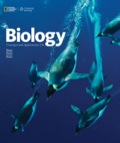
Concept explainers
Introduction:
The pedigree chart helps to depict the complete history of the pattern of inheritance of genetic disease from one generation to another generation. The inheritable genetic disease is either autosomal dominant or recessive or sex-linked based on which the probability of disease in a future generation can be predicted.
Answer to Problem 1SQ
Correct answer:
The pedigree chart is useful in studying the inheritance patterns for organisms that produce few offspring per generation. Hence, the correct answer is option b.
Explanation of Solution
Reason for correct answer:
Option b. is given as “few offspring per generation.”
The pedigree chart is an important analysis tool that helps to carefully evaluate the inheritance patterns and the manner in which the genetic diseases are passed on from one generation to next. This can also help in early diagnosis and treatment
Reason for incorrect answer:
Option a. is given as, “produce many offspring per generation.”
The organisms that have high offspring rate cannot be depicted using a pedigree chart due to the inability to accommodate such large numbers in the graphical representation. Hence, option a. is incorrect.
Option c. is given as, “have a very large chromosome number.”
The gene number does not affect the pedigree chart. Hence, option b. is incorrect.
Option d. is given as, “reproduce asexually.”
The organisms that reproduce asexually do not undergo recombination so cannot be represented through the pedigree chart. Hence, option c. is incorrect.
Option e. is given as, “have a fast life cycle.”
The organisms with a faster life cycle produce a large number of offspring in a given time which cannot be shown through the pedigree chart. Hence, option e. is incorrect
Hence, the options a., c., d and e. are incorrect.
The pedigree chart helps to demonstrate the genetic inheritance of disease in an organism that has few offspring per generation. Thus, the correct answer is b.
Want to see more full solutions like this?
Chapter 14 Solutions
EBK BIOLOGY: CONCEPTS AND APPLICATIONS
- Describe three cranial and postcranial features of Neanderthals skeletons that are likely adaptation to the cold climates of Upper Pleistocene Europe and explain how they are adaptations to a cold climate.arrow_forwardBiology Questionarrow_forward✓ Details Draw a protein that is embedded in a membrane (a transmembrane protein), label the lipid bilayer and the protein. Identify the areas of the lipid bilayer that are hydrophobic and hydrophilic. Draw a membrane with two transporters: a proton pump transporter that uses ATP to generate a proton gradient, and a second transporter that moves glucose by secondary active transport (cartoon-like is ok). It will be important to show protons moving in the correct direction, and that the transporter that is powered by secondary active transport is logically related to the proton pump.arrow_forward
- drawing chemical structure of ATP. please draw in and label whats asked. Thank you.arrow_forwardOutline the negative feedback loop that allows us to maintain a healthy water concentration in our blood. You may use diagram if you wisharrow_forwardGive examples of fat soluble and non-fat soluble hormonesarrow_forward
- Just click view full document and register so you can see the whole document. how do i access this. following from the previous question; https://www.bartleby.com/questions-and-answers/hi-hi-with-this-unit-assessment-psy4406-tp4-report-assessment-material-case-stydu-ms-alecia-moore.-o/5e09906a-5101-4297-a8f7-49449b0bb5a7. on Google this image comes up and i have signed/ payed for the service and unable to access the full document. are you able to copy and past to this response. please see the screenshot from google page. unfortunality its not allowing me attch the image can you please show me the mathmetic calculation/ workout for the reult sectionarrow_forwardIn tabular form, differentiate between reversible and irreversible cell injury.arrow_forwardhelparrow_forward
- Can you please help me answer these questions?arrow_forwardSkryf n kortkuns van die Egyptians pyramids vertel ñ story. Maximum 500 woordearrow_forward1.)What cross will result in half homozygous dominant offspring and half heterozygous offspring? 2.) What cross will result in all heterozygous offspring?arrow_forward
 Biology (MindTap Course List)BiologyISBN:9781337392938Author:Eldra Solomon, Charles Martin, Diana W. Martin, Linda R. BergPublisher:Cengage Learning
Biology (MindTap Course List)BiologyISBN:9781337392938Author:Eldra Solomon, Charles Martin, Diana W. Martin, Linda R. BergPublisher:Cengage Learning
 Concepts of BiologyBiologyISBN:9781938168116Author:Samantha Fowler, Rebecca Roush, James WisePublisher:OpenStax College
Concepts of BiologyBiologyISBN:9781938168116Author:Samantha Fowler, Rebecca Roush, James WisePublisher:OpenStax College Biology: The Dynamic Science (MindTap Course List)BiologyISBN:9781305389892Author:Peter J. Russell, Paul E. Hertz, Beverly McMillanPublisher:Cengage Learning
Biology: The Dynamic Science (MindTap Course List)BiologyISBN:9781305389892Author:Peter J. Russell, Paul E. Hertz, Beverly McMillanPublisher:Cengage Learning Human Heredity: Principles and Issues (MindTap Co...BiologyISBN:9781305251052Author:Michael CummingsPublisher:Cengage Learning
Human Heredity: Principles and Issues (MindTap Co...BiologyISBN:9781305251052Author:Michael CummingsPublisher:Cengage Learning Biology 2eBiologyISBN:9781947172517Author:Matthew Douglas, Jung Choi, Mary Ann ClarkPublisher:OpenStax
Biology 2eBiologyISBN:9781947172517Author:Matthew Douglas, Jung Choi, Mary Ann ClarkPublisher:OpenStax





